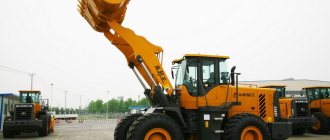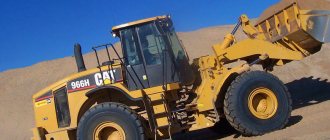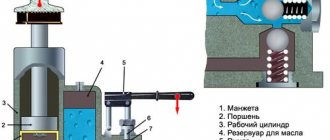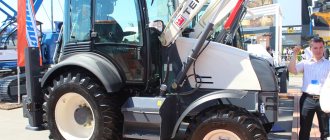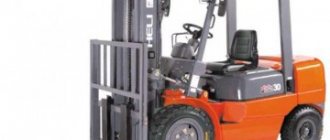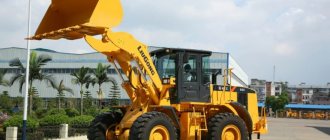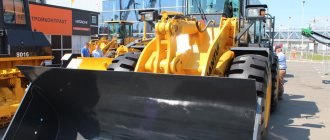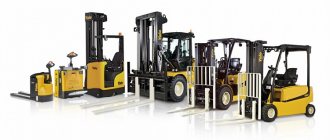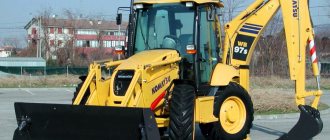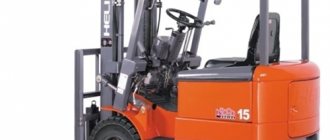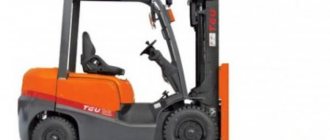The JCB 456 ZX front loader is designed for productive handling of large loads and has proven itself in the construction industry, as it shows good performance and maneuverability even in the most difficult and harsh operating conditions on the construction site and beyond.
JCB 456 ZX front loader
Navigation
- Features and benefits
- Technical characteristics and parameters
- Engine
- Device
- Chassis
- Hydraulic system
- Operator's cabin
- Control system
- Operation and maintenance
- Attachments
- Modifications
- Cost of new and used
- Analogs
Return to navigation
Features and benefits
Features of the JCB 456 ZX front loader are: ease of operation, compliance with quality standards for the amount of noise and emissions produced during operation of the power plant, ease of maintenance and inspection of the machine.
The advantages of the technology include:
- spacious and ergonomic operator's cabin;
- high work productivity;
- reliability;
- long service life, which is achieved thanks to computer monitoring of the machine’s condition under various operating conditions;
- high quality of the main units, which is checked at the equipment manufacturer.
Jisibi 456 ZX loader
When developing the loader, special attention was paid to balancing the weight of the machine and its lifting capacity by reducing the weight of the main elements. To create a strong frame, computer modeling technology was used with a careful calculation of all the main components and the stresses that they can withstand. To reduce the risk of rollover and increase stability, a lower center of gravity is designed. In addition, the safety of both the operator and the machine as a whole is ensured.
Return to navigation
Technical characteristics and parameters
One of the main technical characteristics of the JCB 456 ZX loader is the breakout force, which is 154 kN. This result was achieved by improving the boom mechanism - the rods now have a zigzag shape. This also helps to increase the working area of the machine.
| Parameter | Meaning |
| Operating weight | 22 t |
| Load capacity | 6 t |
| Unloading height | 3.97 m |
| Bucket volume | 3.5 cu. m |
| Breakout force | 154 kN |
| Unloading angle | 45 degrees |
| Tipping load | 12.5 t |
| Maximum travel speed | 37 km/h |
Another technical characteristic of the JCB 456 is the volume of the standard working body. It can vary from 3.1 to 3.5 cc. m and depends on the modification. Thanks to this volume, the loader is capable of performing loading and unloading operations, as well as transporting soil. The maximum unloading length is 1.3 m, and the load capacity is 6 tons, which reduces the time spent on work.
Dimensions of JCB 456 ZX:
| Parameter | Meaning |
| Transport length | 8.52 m |
| Height | 3.37 m |
| Width | 2.7 m |
| Turning radius | 6.7 m |
| Ground clearance | 0.47 m |
| Wheelbase | 3.3 m |
Return to navigation
JCB forklifts - main characteristics of the equipment
JCB forklifts, equipped with a fork lift and a bucket, are designed for loading and transporting various types of cargo. Such loaders are in great demand at industrial enterprises, in agriculture and public utilities, greatly facilitating the process of stacking and transporting goods. Good maneuverability and high maneuverability make this equipment indispensable for solving a number of problems.
The JCB TLT 20 compact forklift with a lifting capacity of 2 tons is equipped with a horizontal telescopic boom and is one of the smallest machines of its type in the world. Small dimensions and sufficient load capacity determine the popularity of this technique. The manufacturer has provided several types of carriages for quickly changing attachments. The internal turning radius is only 2.44 meters, which allows this technique to be used in confined spaces. The maximum lifting height is 4.1 meters.
The JCB 930 forklift is rugged and has a lifting capacity of 3 tonnes. The engine power is 76 hp, a 4-speed synchronized gearbox with a torque converter is installed for smooth switching of the direction of movement. The loader is available in both all-wheel drive and two-wheel drive configurations. The lifting height of a double-frame loader is 3.6 m, and a three-frame loader is 6.5 meters. The JCB 940 loader model has a maximum lifting capacity of 4 tons compared to other JCB loaders.
Engine
JCB 456 ZX power unit
The JCB 456 front loader is equipped with a modern power unit manufactured by Cummins. This is a six-cylinder model with a displacement of 8.3 liters. High power ratings of the power plant (153 kW) and low fuel consumption make the car very economical. The torque of the power plant is 994 Nm. An automatic four-speed gearbox is also installed, ensuring smooth operation of the loader.
| Parameter | Meaning |
| Engine Manufacturer | Cummins |
| Model | 6CT 8.3C |
| Number of cylinders | 6 |
| Power | 153 kW / 210 hp |
| Working volume | 8.3 l |
| Cooling type | liquid |
| Torque | 994 Nm |
| Fuel | diesel |
| Volume of the tank | 370 l |
The main engine components are manufactured by Bosch - pumps, ZF - transmission, Parker - hydraulic distributor. A fan is provided to lower the engine temperature. The exhaust quality complies with the international standard Stage 2.
Return to navigation
Device diagram
This technique, in comparison with analogues, demonstrates the highest performance indicators. This was achieved through the use of a three-pump EcoDig hydraulic system, which is responsible for ensuring the operating level of hydraulic flows even at low engine operating speeds. This system helps save diesel fuel by up to 15 percent. At the same time, it reduces the level of harmful emissions and also increases engine life.
The JCB EcoRoad system helped to increase the power characteristics of the excavator while driving. JCB TorqueLock's innovative technological solution, which locks torque, helps improve efficiency.
Device
All machines are tested under conditions of increased loads, temperature changes, high humidity and high levels of dust in the air. As a result of the inspection, conclusions were drawn about the performance of the equipment and its high technical performance even at temperatures ranging from -20 to +50 degrees. The strength of the joints of the frame elements is determined by computer analysis at their maximum load.
Return to navigation
Chassis
Its main components, such as axles and transmission, are manufactured by ZF. The latter is automatic and four-speed. The combination of these units allows the machine to operate smoothly and eliminates jerking.
| Broadcast | Forward travel, km/h | Reverse, km/h |
| 1 | 6,7 | 6,7 |
| 2 | 13 | 13 |
| 3 | 24,4 | 24,4 |
| 4 | 37 |
The JCB 456 ZX has a top speed of 37 km/h, and with a turning radius of just 6.6 m, the machine is able to work in tight spaces. Initially, it was assumed that the special equipment would be used on weak foundations, so the standard equipment includes a limited slip differential and reliable axles. The first prevents the machine from slipping, and also increases the wear resistance of the tires when working on a solid base.
Return to navigation
JCB mini backhoe loaders
Special equipment designed to work in confined spaces (in a forest, warehouse, factory workshop or narrow city streets) is JCB mini-excavator-loaders. This class includes light models with a lifting capacity of up to two tons.
The JCB skid steer backhoe loader is represented on the Russian market by the JCB 1CX models on standard wheels and the JCB 1CXT on crawler tracks.
This model weighs 2.8 tons and has dimensions of 3.4 × 1.56 × 2.25 m. Moreover, its load capacity is 0.6 tons, and its digging depth is more than 2.5 meters. Bucket capacity is 0.28 cubic meters, maximum horizontal reach is 3.38 m, height is 2.1 m.
The JCB 1CXT model has a slightly larger bucket with a capacity of 0.36 cubic meters.
Engine power Perkins 404D-22 35 kW.
To ensure the stability of the small excavator during operation, it is equipped with “paws”, and the sliding cushions on the outriggers are adjustable.
Hydraulic system
An element of the JCB 456 hydraulic system is a pump with variable displacement. Its power is 326 liters per minute of operation, which guarantees high productivity even when performing several work operations.
To increase efficiency, a variable flow system with increased power (362 liters per minute) and a specially designed hydraulic distributor is provided. To reduce the load on the hydraulic system, unloaded valves are used, which allow the boom mechanism to return to its original position without the use of hydraulic flow.
By rotating the brakes with the same intensity as the wheels, the temperature and friction between the elements are reduced, and efficiency is increased.
Return to navigation
Operator's cabin
Driver's seat of JCB 456 ZX.
Photo The safety of the JCB 456 front loader cab is ensured by the installation of FOPS and ROPS systems, which prevent rollovers and protect the operator and machine from falling objects. In addition, a grille can be installed to perform a protective function. Panoramic visibility is also important, and the special design of the hood allows for unobstructed inspection of the work site. The operator’s field of view also includes the dimensions of the working element, which guarantees not only safety, but also maneuverability. The tinted glazing of the cabin prevents the cabin from heating up inside and UV radiation entering it, and the rear window does not fog up due to the heating installation. Rear view mirrors provide good visibility; they are adjusted manually once.
JCB 456 ZX information display
The JCB 456 HT loader cab is mounted on dampers to reduce vibrations during operation and movement. To protect against dust, increased pressure is built up inside the cabin. The standard equipment includes a heating system that is efficient and quiet. The special equipment is adapted to the harsh Russian winters.
The panels are covered with durable, light-colored plastic that is not susceptible to contamination. The driver's seat is adjustable, as is the steering wheel. This ensures operator comfort and increases productivity. The peripheral working element is easy to control; the system is located under the ceiling. The headlight switch and the car radio niche are located here. Due to this design, there is space for an LCD display on the main panel. It displays information about the operations being performed, and in the event of a malfunction, the cause of its occurrence and location are indicated.
The cabin volume is 3 cubic meters. m.
Return to navigation
Types of forklifts
Loaders are used in industrial enterprises, construction sites and public utilities. The JCB loader line includes several types of equipment for different purposes.
Powerful front-end loaders with a large lifting capacity are used for digging ditches and trenches, earthmoving and road work.
JCB telescopic loaders lift loads to great heights while maintaining cross-country ability and maneuverability.
A loader equipped with a bucket and a fork lifting device is indispensable for stacking and transporting goods in public utilities, agriculture, and industrial enterprises. Like all equipment of the English manufacturer, forklifts have high cross-country ability and maneuverability.
Control system
Modern developments take into account the experience of previous generations of equipment, so each new machine is characterized by a simplified control system.
In the interior of the cabin there is a display that signals malfunctions in the operation of equipment, as well as its current condition. The EMS system diagnoses technical indicators and transmits information about them to the operator via an LCD display.
The driver can choose levers, joystick or auxiliary hydraulic line controls as the control system for the JCB 456 loader. Return to dig, boom lift limit and moving bucket options come standard and are easy to understand and operate.
To control the working body, a sensitive modern hydraulic system is used, providing high performance and accuracy.
If the engine stops or fails, the backup electric power steering pump is activated. The icon with the image of a column is activated on the dashboard. This system is provided for the safety of the operator and the machine, because the engine may fail when driving on public roads, resulting in an emergency situation. If the electric pump is turned on, the driver can stop the equipment without creating obstacles on the road. The hydraulic cylinders that drive the steering wheel are safe because... installed high above the ground - above the frame, which also protects the machine components.
Return to navigation
Scope of application
The unit is designed for loading into a bucket, grabbing, transporting, loading onto vehicle platforms, and storing various materials.
High efficiency machines are used:
- in the movement and storage of soil, bulk and piece goods;
- when distributing building materials over the surface of sites;
- for leveling and small-scale earthmoving work;
- when towing trailers, hauled cargo, etc.
The functionality of the machine is significantly increased by additional removable equipment mounted on the loader boom: road milling machines, loading forks and grab devices, drilling equipment, etc.
Operation and maintenance
A special feature of the JCB 456 ZX front loader is extended service intervals, which makes it more economical. Service work is carried out after 500 operating hours. Due to the small number of hinges in the boom unit, the latter is very reliable and durable.
The main functional components of the equipment are located in such a way that access to them is easy. In addition, they are all protected from mechanical damage and dust. Oil changes are carried out from ground level.
JCB 456 ZX loader. Photo
The Smoothride system reduces dynamic impacts and prevents spillage of bulk materials. The loader assembly may include a central lubrication system that automatically supplies oil to the machine components. This system also has a positive effect on ease of maintenance, because time costs are reduced due to the absence of the need to lubricate these components manually.
Return to navigation
Key advantages and disadvantages of the JCB 4CX
The main advantages include:
- The use of TorqueLock technology, which improved the turning radius of the arrow and the speed of work by 10 percent, and also expanded the working area by 20 percent;
- The presence of an SRS system, which increases operating comfort for the operator by minimizing vibrations;
- Advanced security system JCB LiveLink, which shows the location of equipment by communicating with GPS satellites;
- Automatic transmission, which makes it easier to control the equipment.
Main disadvantages :
- The high cost of the backhoe loader, as well as the high cost of its maintenance;
- Problem with electronics after five years of use;
- High cost of spare parts.
Attachments
The manufacturer provides a large selection of additional working parts, due to which the equipment becomes more versatile. The GCB 456 can be equipped with an extended boom mechanism, buckets of different volumes and types, which help improve the efficiency of working with soils, including category IV. Double-jaw buckets with an individual hydraulic system can also be installed.
Unloading pebbles from a JCB 456 ZX bucket
The most popular attachments are log grabbers and bulldozer blades, which are quickly installed by installing a system for changing working attachments. In this case, the operator does not need to leave the cab and install the necessary equipment himself; the system operates automatically.
Additionally, you can purchase tires of different sizes, which are presented in 12 options and are used depending on operating conditions and load.
Return to navigation
Design features of main components and assemblies
The product is based on two half-frames connected by an articulated unit of a special design, allowing the half-frames to be rotated at an axial angle of up to 40°. Such a scheme made it possible to simplify control of the direction of movement, increased the maneuverability of the machine, which reduced the time spent on the working cycle and increased the output of the unit. Loading equipment is installed on the first half-frame, and the pneumatic wheel axle is attached. The rear semi-frame houses: a diesel unit, transmission units, a rear axle and a control cabin. To increase the traction and coupling parameters of the loader, the bridge assembly is movably fixed to the axis of the unit.
- The power unit is four-stroke diesel engines JCB, Deutz or Cummins with a power of 28-216 kW, water-cooled. The power unit is located behind the cab and does not obstruct the view of the site. The engines are reliable, economical, and meet the requirements of environmental standards.
- Rear-wheel drive or switchable all-wheel drive. The front axle suspension is rigid or single-point, allowing the unit to skew +/- 16°, which increases cross-country ability and maneuverability. Both axles manufactured by ZF are equipped with planetary gear units and differentials with limited friction units. Pneumatic wheels are installed equal in size along the axes.
- Transmissions of hydrostatic, hydromechanical and automatic types are mounted on the machines. Switching modes power, smooth power: Hydrostatic transmission (series 403-409) ensures the transfer of flow energy directly to hydraulic motors that rotate pneumatic wheels through planetary gearboxes. There are no mechanical drives under the machine platform, the ground clearance is increased, and work safety is increased; The ZF Powershift transmission (series 411 and above) for all-wheel drive automatically determines the required torque parameters for a specific operation. The traction force can be increased manually using the control lever. The built-in torque converter and its electrical control change gears without interrupting the power flow. The reverse mode is activated by an electrical circuit with a switch on the steering column.
- Directional control by hydraulic Q-Amp system with operating pressure of 190 bar. The flow pressure acts through a hydraulic cylinder on the half-frame of the articulated unit, changing direction along a short radius. The steering column is adjustable. The steering wheel is designed to operate in emergency mode.
- The hydraulic circuit uses a double gear pump with a flow pressure of 245 bar, mounted on the transmission. The two-section distributor provides a “floating” bucket mode. A hydraulic unit with a backup hydraulic accumulator allows servo control of operating functions using a joystick.
- Multi-disc brakes operate in an oil bath. All-wheel drive, dual hydraulic control circuits and battery backup ensure safe operation.
Modifications
The JCB 456HT features a 4 freestanding cylinder design, wide viewing angle, increased torque, unique seals, bushings and pins for longer service intervals. The boom can be installed as a standard type or with a much increased unloading height.
The JCB 456ZX is characterized by a 3-cylinder design with increased volume, which guarantees increased breakout force and handling performance. Service intervals have been extended for the same reasons as for the JCB 456HT. Boom – standard type or with increased unloading height.
Depending on the quality of the exhaust, the model may have the index “e” in its name, which means compliance with the Tier 3 class, while the standard car belongs to Tier 2.
Return to navigation
Working equipment
The boom structure is attached to the frame of the unit through an axis and rests with the middle part on the rods of the hydraulic cylinders. The bucket is attached to the structure console through a hinge unit.
There are two types of mechanisms for securing the opening and closing of the bucket with a hydraulic cylinder:
- in the Z-mechanism design, the lever support is located between the places where forces are applied, which provides increased breakout force at the edge of the bucket device.
Z-type boom equipment
- in the parallelogram H-mechanism, the lever support is placed on one side with the points of application of forces, which allows for a larger tilting angle of the bucket device, reducing losses of bulk materials during transportation and loading.
H-type boom equipment
- 1 – bucket device; 2 – bucket control levers; 3 – loader pneumatic wheel; 4 – boom device; 5 – tilt cylinder; 6 – lift cylinder; 7 – frame stand.
Models with HT booms are equipped with 4-cylinder geometry and a quick-change equipment carriage.
Z and H models are offered in boom modifications:
- standard lift;
- high rise;
- super high rise.
